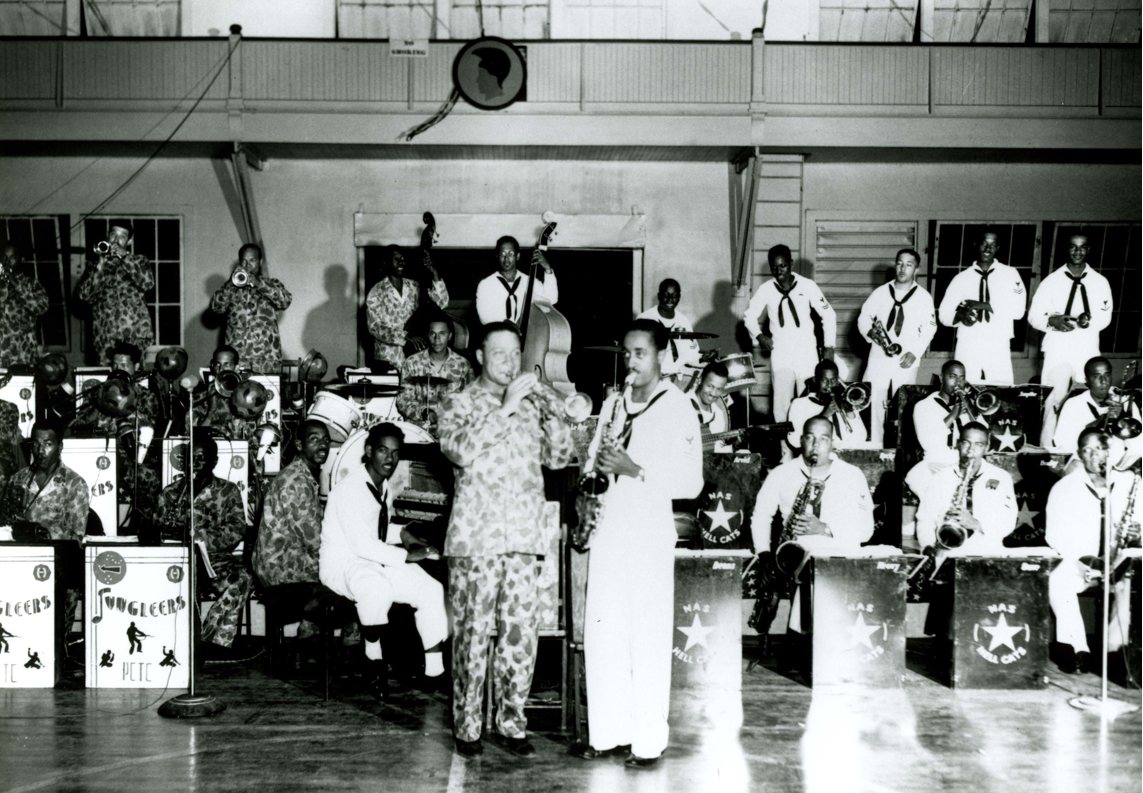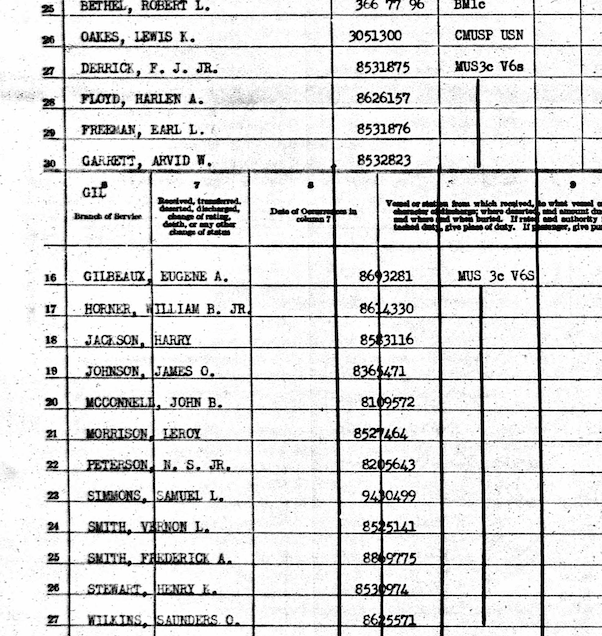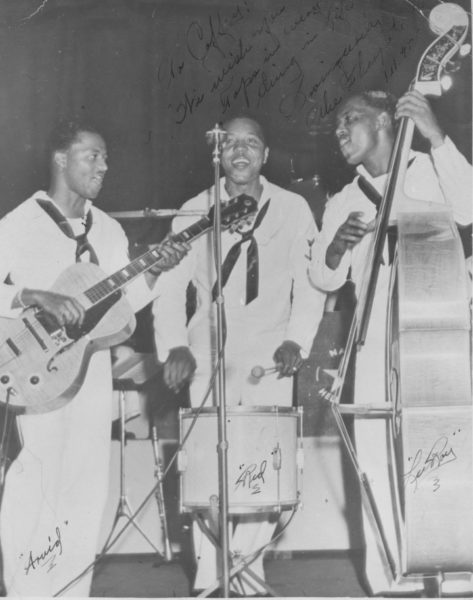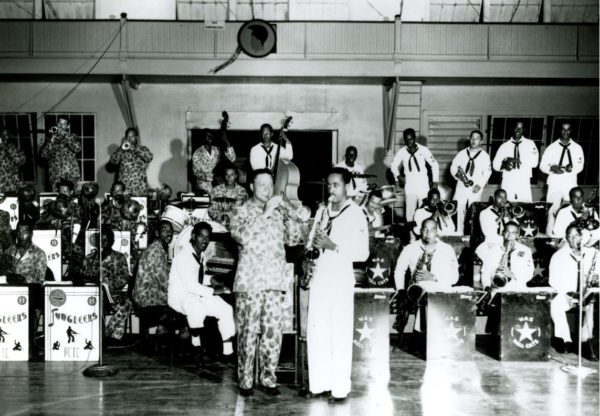
The Army’s Jungleers from the Army Jungle Training Center battle the Hellcats from the Navy’s Barbers Point Station. Photo courtesy of U.S. Army Museum of Hawai’i, Judith Bowman, director
The Hellcats from Barbers Point Naval Air Station was one of the best bands in the Hawaiian islands, and they proved it by winning several of the popular battle-of-the-bands competitions. A March 1945 competition at Schofield Barracks was won by Ray Anthony and his Dolphins, the submarine force band, but B-1’s music critic for the base newspaper, Otto Harris, didn’t like the judges’ decision that put the Hellcats second. “The Hellcats are second only to the Jungleers,” (who were not in this battle) he proclaimed. The number one jazz band from B-1, the Manana Meteors, placed third out of the six bands competing.
The Hellcats boasted one of the top acts in the Sharps and Flats, who had been featured with Duke Ellington’s orchestra before enlisting. They were popular in Chicago before the war and had been features with the Great Lakes Navy radio band, especially on its weekly broadcasts. Thurman O. “Red” Cooper played vibraphone and drums; Arvid M. Garrett, guitar; and Leroy N. Morrison, bass. They shared vocals. As Three Sharps & a Flat they recorded for Decca, Okeh and other labels. Two of their songs are readily available on YouTube.
The Hellcats’ star was trumpeter Harry “Pee Wee” Jackson, from Cleveland, whose nickname was “Gabriel.” He had played with Fatha Hines’ orchestra and Jimmie Lunceford’s band prior to enlisting.
The Hellcats included players who had formerly been in bands fronted by Duke Ellington, Fletcher Henderson, Ella Fitzgerald, Lucky Millinder, Les Hite, Count Basie, Fats Waller, and Tiny Bradshaw.
The band included several college players, representing Alabama State, Temple, West Virginia State, and Atlanta University.
Others in the Barbers Point Hellcats:
• Lonnie Simmons
• Henry Kenneth Stewart, trombone, a graduate of Northwestern University and Chicago Teachers College, who had taught in Chicago public schools for five years before becoming a professional musician
• James Osie Johnson, drums
• William Butler Horner, trumpet, from Detroit
• Frank Derrick, clarinet, arranger, leader of the dance band, from Chicago
• Earle Levon “Von” Freeman, sax & arranger, from Chicago
• Harlan A. Floyd, trombone, from Saginaw, Michigan
• Eugene A. Gilbeaux, from Beaumont, Texas
• John B. McConnell, trombone, from NY City, also arranged for the band. His pre-war compositions included “Rockology” and “The Savoy Is Jumping.”
• Nelson S. Peterson, clarinet, from Hinton, West Virginia
• Frederick A. Smith, trumpet, from Stockton, California
Allen Smith and his cousin, Vernon L. Smith, were originally from Midland, Pennsylvania, and enlisted together. Their uncle, Clarence Smith, was a musician with the 351st Field Artillery band that served in France during World War I.
• Vernon L. Smith, trumpet, from Chicago
• Saunders O. Wilkins, sax, from Detroit
Band Master and Chief Musician Lewis K. Oakes, White, was from Isle, Minn. He composed several of the band’s numbers. His pre-war composition credits include “We’ll be Living in a New World, Baby” and “I’m on the Wrong Side of the World,” which was inspired by his 1937 service in Shanghai.
Von Freeman’s dad was a Chicago policeman who counted Louis Armstrong, Fats Waller, and Earl Hines among his personal friends. He first taught Von to play piano and bought him his first saxophone when he was 7. At DuSable High School, he was taught by Captain Walter Dyett and started playing professionally at 16, when he was hired to play in Horace Henderson’s big band. He enlisted in the Navy soon after high school graduation and served first in the “C” band at Great Lakes before transferring to Barbers Point. “The band traveled everywhere across Hawai’i, and we played all manner of official and social functions for the enlisted men and naval officers,” he said. “Many of those who were in the Hellcats were established professionals who played with Cab Calloway’s and Count Basie’s bands, and they were better than good. They were the best.” He was among the bandsmen honored in Chicago in 2003 as part of the historic Great Lakes Experience.
The band shipped out from San Francisco to Hawai’i on the U.S.S. White Marsh in 1944 with this roster:

Courtesy of US Navy.
 The Sharps & Flats photo at right courtesy of Lisbeth Bock. Photo is autographed to her father, who had seen them perform in Hawai’i.
The Sharps & Flats photo at right courtesy of Lisbeth Bock. Photo is autographed to her father, who had seen them perform in Hawai’i.
Sources
Harris, Otto. “Musically Speaking.” Mananan 13 May 1945: 7.
Harris played was stationed at Manana with US Navy B-1.
Lusser, Jennifer. Email to author. 18 July 2025.
Lusesr’s father, Allen Smith, and his brother, Vernon Smith, were in the Hellcats.
“Submarine Force Band Wins Honors.” Honolulu Advertiser 26 Mar. 1945. 1.
“Two Musicians in Navy Band.” Detroit Tribune. 26 May 1945; 12.
“17-Piece Navy Band Is Tops.” Chicago Defender 28 July 1944: 14. “Star Musicians Triumph in South Pacific Orchestra.” Chicago Defender 15 July 1944: 6.
“Von Freeman.” in A Little Known Legacy: The Great Lakes Experience: A Salute to African-American Navy Bandsmen at the Great Lakes Naval Base 1942-45 [Chicago, IL] [Feb. 2003]. Collection of Carl Foster.
Photo note: The U.S.Army photograph of the Jungleers and Hellcats is identified as having been taken at a war bond rally in the Hawaiian Armory, June 19, 1945. Some have identified John Coltrane as one of the saxophonists in it. Assuming the date is correct, it could not have pictured John Coltrane, who had not joined the Navy at this time. He was later stationed at the Navy’s Manana Barracks, where he played with the Melody Masters, who replaced B-1.
21 July 2025
